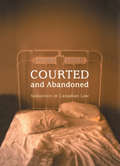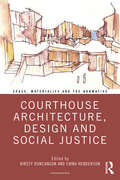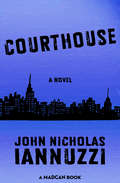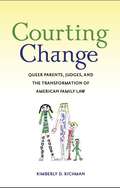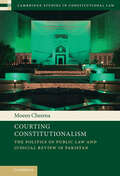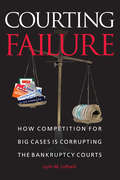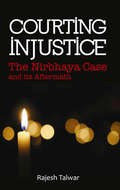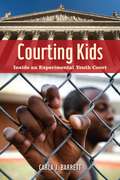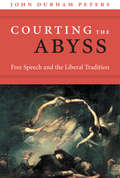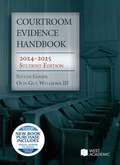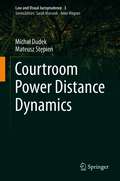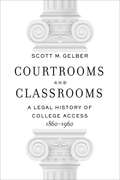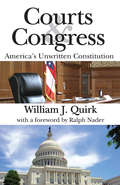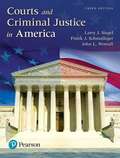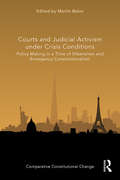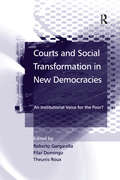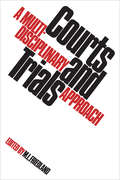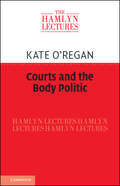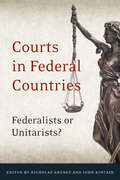- Table View
- List View
Court-Martial: How Military Justice Has Shaped America from the Revolution to 9/11 and Beyond
by Chris BrayA timely, provocative account of how military justice has shaped American society since the nation's beginnings. With a great eye for narrative, historian Chris Bray (himself a former soldier) tells the sweeping story of military justice from the institution of the court martial in the earliest days of the Republic to contemporary arguments over how to use military courts to try foreign terrorists or soldiers accused of sexual assault. Bray recounts the stories of famous American court martials, including those involving President Andrew Jackson, Gen. William Tecumseh Sherman, Lt. Jackie Robinson, and Pvt. Eddie Slovik; he explores how encounters of freed slaves with the military justice system during the Civil War anticipated the Civil Rights movement; and he explains how the Uniform Code of Military Justice came about after World War II. Throughout, he shows that the separate justice system of the armed forces has often served as a proxy for America's ongoing arguments over equality, privacy, discrimination, security, and liberty.
Courted and Abandoned
by Patrick BrodeA pregnancy outside of marriage was a traumatic event in frontier Canada, one that had profound legal implications, not only for the mother, but also for the woman's family, the alleged father, and for the entire community. Patrick Brode examines the history of the 'heartbalm' torts in nineteenth-century Canada - breaches of duty leading to liability for damages for seduction, breach of promise of marriage, and criminal conversation - that were part of the inherited English law and were a major feature of early Canadian law.Encompassing all ten Canadian provinces, Brode's study examines the court cases and the communities in which they arose. He illustrates the progression of these 'heartbalm' actions as women gained more and more autonomy in the late nineteenth century, until questions arose as to the applicability of these feudal remedies in a modern society. He argues that the heartbalm cases are a testament to how early Canadians tried to control sexuality and courtship, even consensual activity among adults. In mixing legal and social issues, and showing how they interact, Courted and Abandoned makes a significant contribution to legal history, women's studies, and cultural history.
Courthouse Architecture, Design and Social Justice
by Emma Henderson Kirsty DuncansonThis collection interrogates relationships between court architecture and social justice, from consultation and design to the impact of material (and immaterial) forms on court users, through the lenses of architecture, law, socio-legal studies, criminology, anthropology, and a former high court judge. International multidisciplinary collaborations and single-author contributions traverse a range of methodological approaches to present new insights into the relationship between architecture, design, and justice. These include praxis, photography, reflections on process and decolonising practice, postcolonial, feminist, and poststructural analysis, and theory from critical legal scholarship, political science, criminology, literature, sociology, and architecture. While the opening contributions reflect on establishing design principles and architectural methodologies for ethical consultation and collaboration with communities historically marginalised and exploited by law, the central chapters explore the textures and affects of built forms and the spaces between; examining the disjuncture between design intention and use; and investigating the impact of architecture and the design of space. The collection finishes with contemplations of the very real significance of material presence or absence in courtroom spaces and what this might mean for justice. Courthouse Architecture, Design and Social Justice provides tools for those engaged in creating, and reflecting on, ethical design and building use, and deepens the dialogue across disciplinary boundaries towards further collaborative work in the field. It also exists as a new resource for research and teaching, facilitating undergraduate critical thought about the ways in which design enhances and restricts access to justice.
Courthouse: A Novel
by John Nicholas IannuzziThe blistering novel of a courageous young lawyer in a big-city jungle of mob violence, corrupt courts, political intrigue, and dangerous passion! In the hushed halls of justice, Marc Conte was dynamite. From quiet air-conditioned courtrooms to seething New York streets, Courthouse follows Conte--the city's brightest young criminal lawyer--as he grapples with the most dangerous adversaries a lawyer ever faced: corrupt DAs and crooked judges; political backstabbers who could end a young lawyer's career for good; and women willing to do anything for his services. Ahead of Conte are his three most challenging cases--and a slashing confrontation with the seamy side of the American legal system. With all the explosive reality of the passions it portrays, Courthouse propels the reader into the tumultuous world of Marc Conte, trial lawyer.
Courting Change: Queer Parents, Judges, and the Transformation of American Family Law
by Kimberly D. RichmanWinner of the 2010 Pacific Sociological Association Distinguished Contribution to Scholarship AwardA lesbian couple rears a child together and, after the biological mother dies, the surviving partner loses custody to the child’s estranged biological father. Four days later, in a different court, judges rule on the side of the partner, because they feel the child relied on the woman as a “psychological parent.” What accounts for this inconsistency regarding gay and lesbian adoption and custody cases, and why has family law failed to address them in a comprehensive manner?In Courting Change, Kimberly D. Richman zeros in on the nebulous realm of family law, one of the most indeterminate and discretionary areas of American law. She focuses on judicial decisions—both the outcomes and the rationales—and what they say about family, rights, sexual orientation, and who qualifies as a parent. Richman challenges prevailing notions that gay and lesbian parents and families are hurt by laws’ indeterminacy, arguing that, because family law is so loosely defined, it allows for the flexibility needed to respond to—and even facilitate — changes in how we conceive of family, parenting, and the role of sexual orientation in family law.Drawing on every recorded judicial decision in gay and lesbian adoption and custody cases over the last fifty years, and on interviews with parents, lawyers, and judges, Richman demonstrates how parental and sexual identities are formed and interpreted in law, and how gay and lesbian parents can harness indeterminacy to transform family law.
Courting Conflict: The Israeli Military Court System in the West Bank and Gaza
by Lisa HajjarThis book provides a rare look at an institution that lies both figuratively and literally at the center of the Israeli-Palestinian conflict. Lisa Hajjar has conducted in-depth interviews with dozens of Israelis and Palestinians--including judges, prosecutors, defense lawyers, defendants, and translators--about their experiences and practices to explain how this system functions, and how its functioning has affected the conflict.
Courting Constitutionalism: The Politics of Public Law and Judicial Review in Pakistan (Cambridge Studies in Constitutional Law)
by Moeen CheemaOver the last decade, the Supreme Court of Pakistan has emerged as a powerful and overtly political institution. While the strong form of judicial review adopted by the Supreme Court has fostered the perception of a sudden and ahistorical judicialisation of politics, the judiciary's prominent role in adjudicating issues of governance and statecraft was long in the making. This book presents a deeply contextualised account of law in Pakistan and situates the judicial review jurisprudence of the superior courts in the context of historical developments in constitutional politics, evolution of state structures and broader social transformations. This book highlights that the bedrock of judicial review has remained in administrative law; it is through the consistent development of the 'Writ jurisdiction' and the judicial review of administrative action that Pakistan's superior courts have progressively carved an expansive institutional role and aggrandised themselves to the status of the regulator of the state.
Courting Death
by Carol S. SteikerRefusing to eradicate the death penalty, the U.S. has attempted to reform and rationalize capital punishment through federal constitutional law. While execution chambers remain active in several states, Carol Steiker and Jordan Steiker argue that the fate of the American death penalty is likely to be sealed by this failed judicial experiment.
Courting Death: A Novel (The\clarkeston Chronicles Ser. #3)
by Paul HealdFrom an internationally recognized law professor comes the third legal thriller in an exciting mystery series, the Clarkeston Chronicles.Courting Death finds Melanie Wilkerson (from Cotton, book two of the Clarkeston Chronicles) and Arthur Hughes working uncomfortably together in the chambers of a famous federal judge. While Melanie neglects her duties as a law clerk to investigate the mysterious death of a young woman in the courthouse five years earlier, Arthur wades through the horrific habeas corpus appeals of two prisoners: an infamous serial killer and a pathetic child murder.Melanie, a Georgia native who returns from law school in the Northeast, hoped to establish a legal reputation that will eclipse her beauty pageant queen past, which she is now desperate to disown. Arthur is a bright but naive Midwesterner who is rapidly seduced by the small Georgia college town of Clarkeston which, to his surprise, comes with an exotic and attractive landlady. The cohort of federal court clerks is completed by Phil Jenkins, a Stanford graduate from San Francisco who tries his best to balance the personalities of his volatile colleagues.Living and working in bucolic Clarkeston comes with a price. In Courting Death, Arthur, Melanie, and Phil are confronted with the extremes of human mortality, both in and outside the legal system, in ways that they could never have expected or prepared for.Skyhorse Publishing, as well as our Arcade, Yucca, and Good Books imprints, are proud to publish a broad range of books for readers interested in fiction-novels, novellas, political and medical thrillers, comedy, satire, historical fiction, romance, erotic and love stories, mystery, classic literature, folklore and mythology, literary classics including Shakespeare, Dumas, Wilde, Cather, and much more. While not every title we publish becomes a New York Times bestseller or a national bestseller, we are committed to books on subjects that are sometimes overlooked and to authors whose work might not otherwise find a home.
Courting Failure
by Lynn M. LopuckiLoPucki's provocative critique of Chapter 11 is required reading for everyone who cares about bankruptcy reform. This empirical account of large Chapter 11 cases will trigger intense debate both inside the academy and on the floor of Congress. Confronting LoPucki's controversial thesis-that competition between bankruptcy judges is corrupting them-is the most pressing challenge now facing any defender of the status quo. " -Douglas Baird, University of Chicago Law School "This book is smart, shocking and funny. This story has everything-professional greed, wrecked companies, and embarrassed judges. Insiders are already buzzing. " -Elizabeth Warren, Leo Gottlieb Professor of Law, Harvard Law School "LoPucki provides a scathing attack on reorganization practice. Courting Failurerecounts how lawyers, managers and judges have transformed Chapter 11. It uses empirical data to explore how the interests of the various participants have combined to create a system markedly different from the one envisioned by Congress. LoPucki not only questions the wisdom of these changes but also the free market ideology that supports much of the general regulation of the corporate sector. " -Robert Rasmussen, University of Chicago Law School A sobering chronicle of our broken bankruptcy-court system,Courting Failureexposes yet another American institution corrupted by greed, avarice, and the thirst for power. Lynn LoPucki's eye-opening account of the widespread and systematic decay of America's bankruptcy courts is a blockbuster story that has yet to be reported in the media. LoPucki reveals the profound corruption in the U. S. bankruptcy system and how this breakdown has directly led to the major corporate failures of the last decade, including Enron, MCI, WorldCom, and Global Crossing. LoPucki, one of the nation's leading experts on bankruptcy law, offers a clear and compelling picture of the destructive power of "forum shopping," in which corporations choose courts that offer the most favorable outcome for bankruptcy litigation. The courts, lured by big money and prestige, streamline their requirements and lower their standards to compete for these lucrative cases. The result has been a series of increasingly shoddy reorganizations of major American corporations, proposed by greedy corporate executives and authorized by case-hungry judges.
Courting Injustice: The Nirbhaya Case and Its Aftermath
by Rajesh TalwarIn this partnership between so-called equals, which can be compared to a polyandrous marriage, the Supreme Court is the woman and Parliament and the Executive her two husbands, one more loutish that the other, depending on your point of view. In the Nirbhaya case too the gap between theory and law has been highlighted. Following the terrible episode, (and even before) there has been continual and great improvement in the substantive laws for both women as well as children who have been victims of sexual violence. And yet despite their being so much publicity on the case, the author argues that, concretely, although there has been improvement in the laws themselves, we are nowhere near better enforcement or implementation. Even after the institution of a fast track trial, and with the nation’s attention focused on it, the Nirbhaya case still dragged on and it took more than nine months for the trial court to reach a verdict. And, as the author explains there are still potentially further delays waiting at the level of the superior courts, the High Court certainly and the Supreme Court too, quite possibly. As the author goes on to show in this well argued book, a woman who is the victim of a sex related crime ‘courts injustice’ whenever she comes to a court, be she the victim of a rape, an acid attack, of sexual harassment; the mother or father of such a victim or be it even any ordinary person struggling to find justice. Our courts, particularly the Supreme Court is performing the function of a nagging wife. Time and again she pulls up the lazy, good-for-nothing husbands (read ‘failure of governance’). And what does either husband do? He goes for a walk, ignoring the wife’s anguished screams even as they follow him. If she complains too much, he tells himself, he’ll see to it that she doesn’t get the silk sari and other goodies she wants (read ‘promotions’, ‘post retirement assignments’, etc). It is only one of the ways he ensures that she doesn’t step too much out of line. All wives nag, he consoles himself. Nagging here and there is tolerable but she must make sure that he gets his meals on time (read ‘doesn’t bar him from contesting elections even if there are a dozen or more criminal cases pending against him’). Meanwhile the overzealous wife doesn’t realize that while she rails and rants against the erring ways of her husband, the dishes are piling up in the kitchen. And the maid has gone away for six months and the dishes, they are piling up (read, the arrears are accumulating)! The time has come. It cannot continue to remain ‘business as usual’. There will be justice for Nirbhaya. Our ‘brave heart’ will also bring justice and relief to all her sisters. And possibly, even to the rest of us.
Courting Kids: Inside an Experimental Youth Court (Alternative Criminology #25)
by Carla J. BarrettDespite being labeled as adults, the approximately 200,000 youth under the age of 18 who are now prosecuted as adults each year in criminal court are still adolescents, and the contradiction of their legal labeling creates numerous problems and challenges. In Courting Kids Carla Barrett takes us behind the scenes of a unique judicial experiment called the Manhattan Youth Part, a specialized criminal court set aside for youth prosecuted as adults in New York City. Focusing on the lives of those coming through and working in the courtroom, Barrett’s ethnography is a study of a microcosm that reflects the costs, challenges, and consequences the “tough on crime” age has had, especially for male youth of color. She demonstrates how the court, through creative use of judicial discretion and the cultivation of an innovative courtroom culture, developed a set of strategies for handling “adult-juvenile ” cases that embraced, rather than denied, defendants’ adolescence.
Courting the Abyss: Free Speech and the Liberal Tradition
by John Durham PetersCourting the Abyss updates the philosophy of free expression for a world that is very different from the one in which it originated. The notion that a free society should allow Klansmen, neo-Nazis, sundry extremists, and pornographers to spread their doctrines as freely as everyone else has come increasingly under fire. At the same time, in the wake of 9/11, the Right and the Left continue to wage war over the utility of an absolute vision of free speech in a time of increased national security. Courting the Abyss revisits the tangled history of free speech, finding resolutions to these debates hidden at the very roots of the liberal tradition. A mesmerizing account of the role of public communication in the Anglo-American world, Courting the Abyss shows that liberty's earliest advocates recognized its fraternal relationship with wickedness and evil. While we understand freedom of expression to mean "anything goes," John Durham Peters asks why its advocates so often celebrate a sojourn in hell and the overcoming of suffering. He directs us to such well-known sources as the prose and poetry of John Milton and the political and philosophical theory of John Locke, Adam Smith, John Stuart Mill, and Oliver Wendell Holmes Jr., as well as lesser-known sources such as the theology of Paul of Tarsus. In various ways they all, he shows, envisioned an attitude of self-mastery or self-transcendence as a response to the inevitable dangers of free speech, a troubled legacy that continues to inform ruling norms about knowledge, ethical responsibility, and democracy today. A world of gigabytes, undiminished religious passion, and relentless scientific discovery calls for a fresh account of liberty that recognizes its risk and its splendor. Instead of celebrating noxious doctrine as proof of society's robustness, Courting the Abyss invites us to rethink public communication today by looking more deeply into the unfathomable mystery of liberty and evil.
Courtroom Evidence Handbook, 2024-2025 Student Edition
by Olin Wellborn III Steven GoodeNew book purchase includes complimentary digital access to the eBook. Designed both for law student advocates and students enrolled in traditional evidence courses, this handbook provides full coverage of courtroom evidence procedures, rules, and law. It contains the Federal Rules of Evidence, including recent and pending amendments; offers rule-by-rule commentary, serving as a mini-treatise on federal rules; and covers objections and responses. It is indispensable for students participating in a mock trial, going to court as part of a clinical program, or trying to understand the law of evidence. It also helps students bridge the gap from understanding the law of evidence to understanding how to perform at trial.
Courtroom Power Distance Dynamics (Law and Visual Jurisprudence #3)
by Mateusz Stępień Michał DudekThe book presents a comprehensive reconceptualization of Geert Hofstede’s well-known concept of power distance, applying the theory to the specific case of judge–witness courtroom interactions in Polish regional courts. In the light of the detailed critique of Hofstede’s original approach to power distance, the book first carefully develops a three-level concept of power distance, including personal preferences concerning the realization of power relations (subjective level); rules, practices and spatio-architectural arrangements underlying power relations (organizational level); and individual demeanors that can, in practice, increase or decrease the asymmetry between parties to a power relation (interactional level). This reconceptualization provides a universal conceptual apparatus that is applicable to various social settings, but the authors have used it in extensive qualitative and quantitative research focused on courtroom interactions. After laying the theoretical foundations, the book details the elements of judge–witness courtroom interactions (both verbal and non-verbal) that contribute to establishing power distance between judge and witness. These were identified over 6 months of observational research conducted in 2018 in the Kraków regional courts. Lastly, the book addresses the issue of the relationship between the subjective level of power distance and opinions that laypeople can have concerning a judge’s demeanor in the courtroom environment. To do so, it describes specific quantitative research that involved the creation of original film clips depicting witness questioning by the judge in a courtroom in three power distance situations. Offering a coherent framework for examining various interpersonal relations in legal contexts and illustrating how the framework can be applied on the courtroom interactions example, the book will appeal to a wide range of legal practitioners and academics. It also allows scientists outside the legal field to gain a new and broad understanding of power distance that they can easily apply in their respective fields. Furthermore, it provides non-academics with insights into courtroom interactional dynamics, as exemplified by the discussion of Polish judicial practice.
Courtrooms and Classrooms: A Legal History of College Access, 1860−1960
by Scott M. GelberA stunningly original history of higher education law.Conventional wisdom holds that American courts historically deferred to institutions of higher learning in most matters involving student conduct and access. Historian Scott M. Gelber upends this theory, arguing that colleges and universities never really enjoyed an overriding judicial privilege.Focusing on admissions, expulsion, and tuition litigation, Courtrooms and Classrooms reveals that judicial scrutiny of college access was especially robust during the nineteenth century, when colleges struggled to differentiate themselves from common schools that were expected to educate virtually all students. During the early twentieth century, judges deferred more consistently to academia as college enrollment surged, faculty engaged more closely with the state, and legal scholars promoted widespread respect for administrative expertise. Beginning in the 1930s, civil rights activism encouraged courts to examine college access policies with renewed vigor.Gelber explores how external phenomena—especially institutional status and political movements—influenced the shifting jurisprudence of higher education over time. He also chronicles the impact of litigation on college access policies, including the rise of selectivity and institutional differentiation, the decline of de jure segregation, the spread of contractual understandings of enrollment, and the triumph of vocational emphases.
Courts and Congress: America's Unwritten Constitution
by William QuirkIt's often said, confirmed by survey data, that the American people are losing confidence in their government. But the problem may be the reverse--the government has lost confidence in the people. Increasingly the power to make decisions in our democracy has been shifted from Congress to the court system, forcing non-elected officials to make decisions which affect the lives of Americans. In a society which is based on the democratic elections of its officials, this is clearly backwards.Quirk maintains that what he calls "The Happy Convention," an informal and unwritten rearrangement of "passing the buck" of government powers, is done to avoid blame and approval ratings becoming lower for a particular person or party. For example, The Happy Convention assigns the power to declare and make war to the President. Congress and the Court play a supporting role--Congress, when requested, gives the President a blank check to use force--the Court throws out any challenges to the legality of the war. Everyone wins if the war avoids disaster. If it turns out badly, the President is held accountable. His ratings fall, reelection is out of the question, congressmen say he lied to them; his Party is likely to lose the next election.In this way, Quirk reminds us that The Happy Convention is not what the Founders intended for us. For democracy to work properly, the American people have to know what options they have. Courts and Congress argues the case for reestablishing the balance of powers between the courts, the Congress, and the Presidency.
Courts and Criminal Justice in America
by Frank Schmalleger Larry J. Siegel John L. WorrallCourts and Criminal Justice in America, Third Edition, is the collaboration of the most popular criminal justice authors of the century. Featuring a balanced and modern presentation, this book not only looks at the basic structure of the court system and court process, but also covers cutting-edge topics and all sides of the most controversial issues facing courts today. This student-friendly text does not presuppose any knowledge about the courts or how they operate. Highlighted controversial cases illustrate the tremendous power that the court system has to regulate citizens' lives, to shape what is acceptable and what is forbidden, and to ensure that criminal justice policy balances both rights and liberties. Extensively revised throughout, the Third Edition features new and updated statistics, chapter-opening stories, and Courts in the News and What Will You Do? features that challenge readers to think critically and draw their own conclusions. This respected author team delivers the most comprehensive introduction to America's courts, their personnel, and the context in which they operate on the market today.
Courts and Judicial Activism under Crisis Conditions: Policy Making in a Time of Illiberalism and Emergency Constitutionalism (Comparative Constitutional Change)
by Martin BelovThis collection examines topical issues related to the impact of courts on constitutional politics during extreme conditions. The book explores the impact of activist courts on democracy, separation of powers and rule of law in times of emergency constitutionalism. It starts with a theoretical explanation of the concept, features and main manifestations of judicial activism and its impact in shaping the relationship between constitutional, international and supranational law. It then focuses on judicial activism in extreme conditions, for example, in times of emergencies and pandemics, or in the context of democratic backsliding, authoritarian constitutionalism and illiberal constitutionalism. Thus, the book may be considered as a contribution to the debates on judicial activism, including the discussion of the impact of courts on certainty, proportionality and balancing of rights, as well as on revolutionary courts challenging authoritarian context and generally over the role of courts in the context of illiberalism and democratic backsliding. The volume thus offers an explanation of the concept of judicial activism, its impact on both the legal system and the political order and the role of courts in shaping the structures of the legal order. These issues are explored in theoretical and comparative constitutional perspectives. The book will be a valuable resource for academics and researchers working in the areas of courts, constitutional law and constitutional politics.
Courts and Kids: Pursuing Educational Equity Through the State Courts
by Michael A. RebellThe first detailed analysis of why the state courts have taken on this active role and how successful their efforts have been. Since 1973, litigants have challenged the constitutionality of education finance systems in forty-five states on the grounds that they deprive many poor and minority students of adequate access to a sound education.
Courts and Social Transformation in New Democracies: An Institutional Voice for the Poor?
by Roberto Gargarella Theunis RouxUsing case studies drawn from Latin America, Africa, India and Eastern Europe, this volume examines the role of courts as a channel for social transformation for excluded sectors of society in contemporary democracies. With a focus on social rights litigation in post-authoritarian regimes or in the context of fragile state control, the authors assess the role of judicial processes in altering (or perpetuating) social and economic inequalities and power relations in society. Drawing on interdisciplinary expertise in the fields of law, political theory, and political science, the chapters address theoretical debates and present empirical case studies to examine recent trends in social rights litigation.
Courts and Trials: A Multidisciplinary Approach
by Martin L. FriedlandThe judicial system occupies an important place in society, yet it has been one of the least studied of Canadian institutions. Traditionally, examination and criticism of the trial process have been left to lawyers and members of the legal profession. In this volume nine non-lawyers scrutinize its operation in Canada from the perspectives of several academic disciplines. Reginald Allen, a philosopher and classicist, discusses the modern trial process in the light of the trial of Socrates; Anatol Rapoport, a mathematician noted for his work in the fields of game theory and conflict resolution, analyses the adversary system from Charles Hanly, a philosopher and psychoanalyst, uses the Truscott case to explore the psychopathological aspects of a trial from a Freudian viewpoint; one political scientist, Peter Russell, examine the courts' role in the development of the law; another, Donald Smiley, studies their role as protector of civil liberties; James Giffen, a sociologist, points out the inadequacy of the criminal justice system as a means of controlling alcohol and drug addiction; Donald Dewees, an economist, examines court regulation of economic behaviour; and Kenneth McNaught, a historian, discusses the political trial in the Canadian legal system.
Courts and the Body Politic (The Hamlyn Lectures)
by Kate O'ReganOver the last half century, courts have come to play increasingly important roles in democracies. That role is studied by historians, political scientists, constitutional lawyers and political theorists, but it is also important to all who are concerned about the practice and future of democracy. This book explores why it is that courts are playing this expanded role, as well as exploring two of the most distinctive features of the role of courts: their relationship with the executive arm of government and the role of courts in protecting fundamental rights. The book argues that the role played by courts in modern democracies varies across time and place and depends on a range of factors including constitutional text, constitutional history, and legal and political culture. This book draws on Justice O'Regan's experience as one of the first judges on South Africa's Constitutional Court, which was established shortly after the transition to democracy in 1994.
Courts in Federal Countries: Federalists or Unitarists?
by John Kincaid Nicholas Theodore AroneyCourts are key players in the dynamics of federal countries since their rulings have a direct impact on the ability of governments to centralize and decentralize power. Courts in Federal Countries examines the role high courts play in thirteen countries, including Australia, Brazil, Canada, Germany, India, Nigeria, Spain, and the United States. The volume’s contributors analyse the centralizing or decentralizing forces at play following a court’s ruling on issues such as individual rights, economic affairs, social issues, and other matters. The thirteen substantive chapters have been written to facilitate comparability between the countries. Each chapter outlines a country’s federal system, explains the constitutional and institutional status of the court system, and discusses the high court’s jurisprudence in light of these features. Courts in Federal Countries offers insightful explanations of judicial behaviour in the world’s leading federations.
Courts in Latin America
by Gretchen Helmke Julio Ríos-FigueroaTo what extent do courts in Latin America protect individual rights and limit governments? This volume answers these fundamental questions by bringing together today's leading scholars of judicial politics. Drawing on examples from Argentina, Brazil, Chile, Mexico, Colombia, Costa Rica, and Bolivia, the authors demonstrate that there is widespread variation in the performance of Latin America's constitutional courts. In accounting for this variation, the contributors push forward ongoing debates about what motivates judges; whether institutions, partisan politics, and public support shape interbranch relations; and the importance of judicial attitudes and legal culture. The authors deploy a range of methods, including qualitative case studies, paired country comparisons, statistical analysis, and game theory.

